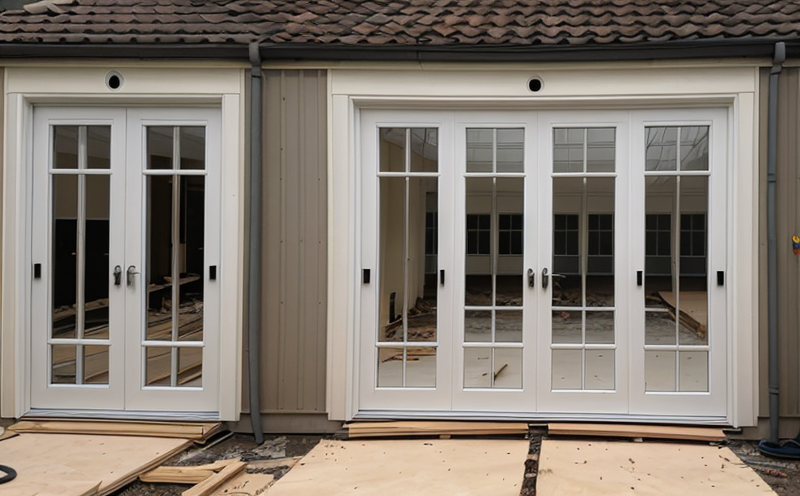Insulation Testing of Partition Systems
The insulation testing of partition systems is a critical aspect within fire safety testing, particularly in sectors such as commercial buildings, hospitals, and residential complexes. Partitions play a vital role in protecting life and property during fires by providing thermal barriers that prevent the spread of heat and flames. This service ensures compliance with international standards like ISO 834:2016 and EN 13501-1, which specify the requirements for fire resistance tests.
Partition systems are often made from a combination of materials such as gypsum, concrete, steel, or wood, each contributing to their overall thermal insulation properties. Testing these systems involves assessing their ability to maintain structural integrity and resist heat penetration over time. The primary objective is to ensure that partitions can effectively contain fire within an area of origin for at least the duration specified by local regulations.
The testing process typically begins with detailed preparation of specimens according to standard procedures. Specimens are cut from actual construction materials used in partition walls or floors, ensuring they accurately represent real-world conditions. Once prepared, the specimens undergo exposure to controlled heat sources in specialized furnaces designed for fire resistance tests.
During testing, it’s essential to monitor various parameters including temperature rise on both sides of the partition and the amount of heat transferred through it. These measurements help determine whether the material meets required performance levels outlined by relevant standards.
A well-executed insulation test not only verifies compliance with regulatory requirements but also provides valuable insights into improving design and manufacturing practices for better fire safety outcomes. By identifying weaknesses early in development stages, manufacturers can enhance product quality while reducing risks associated with non-compliance penalties or potential losses due to accidents.
Why It Matters
The importance of effective insulation testing cannot be overstated when it comes to ensuring public safety and preventing catastrophic failures during fires. In buildings where partitions are used extensively, such as hospitals or schools, proper insulation is crucial for protecting occupants from exposure to toxic smoke and high temperatures.
- Ensures compliance with international standards
- Improves design and manufacturing practices
- Promotes safer environments for workers and visitors
- Reduces the risk of accidental fires spreading rapidly through poorly insulated partitions
- Enhances overall structural integrity during extreme conditions
- Aids in meeting insurance requirements and reducing liability risks
In today’s increasingly stringent regulatory landscape, compliance with these standards is essential for maintaining a competitive edge. Non-compliance can lead to significant financial losses resulting from penalties, product recalls, or even business closures due to safety concerns.
Quality and Reliability Assurance
Incorporating robust quality assurance measures into the insulation testing process ensures reliable results that can be trusted by stakeholders across various sectors. This includes implementing strict quality control procedures throughout specimen preparation, furnace operation, data collection, and analysis.
The first step in maintaining high-quality standards involves using calibrated equipment to accurately measure temperature changes on both sides of partition specimens during testing. Regular calibration checks ensure consistent performance over time, reducing the likelihood of erroneous readings that could mislead decision-makers.
Another key aspect is maintaining a clean and controlled environment within the furnace chambers to minimize external factors influencing test outcomes. This helps in obtaining repeatable results that are representative of real-world scenarios where partitions might be exposed to intense heat sources.
Data integrity is also critical, with comprehensive documentation being maintained for each specimen tested. This includes recording initial dimensions, applied loads if applicable, observed behavior under fire exposure conditions, and final measurements after testing has concluded. Such detailed records provide valuable information not only during current projects but also serve as references for future improvements.
By adhering to rigorous quality assurance protocols, laboratories can demonstrate their commitment to delivering accurate, reliable results that contribute positively towards enhancing public safety.
Competitive Advantage and Market Impact
- Enhances brand reputation through adherence to international standards
- Promotes sustainable development practices by optimizing material usage
- Fosters innovation within the construction industry by driving research into more effective insulation solutions
- Supports continuous improvement efforts aimed at reducing fire risks in built environments
- Aids in maintaining competitive positioning amidst evolving market demands for safer products and services
- Facilitates easier entry into new markets where stringent regulatory requirements may apply
- Encourages collaboration between stakeholders including manufacturers, architects, and builders towards common goals of improved fire safety performance
The ability to consistently deliver reliable insulation test results positions laboratories as trusted partners for businesses operating in high-risk industries. By staying ahead of changing regulations and technological advancements, these organizations can ensure they remain relevant in an ever-evolving market landscape.





